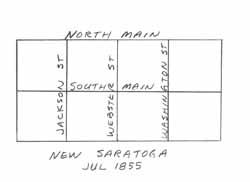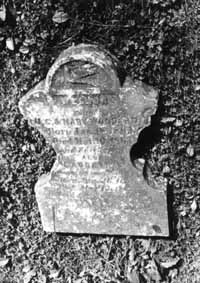Saratoga, a "Paper" Town
By Martin E. Nass
Transcribed for the IAGenWeb Project by Janelle Martin, with permission of Martin "Ed" Nass.
In 1855 the earliest local settlers were located in Webster County when
two new towns were platted. One was situated on the Boone River and
consisted of eight blocks. It was named Newcastle. The other was also
situated on the Boone River and consisted of eight blocks. It was named
New Saratoga. Newcastle became Webster City, while New Saratoga is now
farmland.

Jacob Omstead hired Israel Woodard to survey his town plat. Since no
name had been given for the new town, Woodard suggested New Saratoga in
honor of his former home in Saratoga Springs, New York. His sister,
Margaret, lived near the platted town, and there was a spring on her
farm. Thus the name seemed appropriate. The plat was filed at the
courthouse on July 24, 1855. The north-south streets were named Jackson,
Webster, and Washington. The east-west streets were North Main and South
Main. This plat was in Section 12, Webster Township, 87N, R26W. Today
that location is near the intersection of 300th Street and Inkpaduta
Avenue. A picture of the plat is found in this article.
Though many settlers came to the area, the town never prospered. A small
school was built in the town plat on the west side of Inkpaduta, but it
was soon replaced with a larger frame school house across the street. In
1865, Samuel G. Layne came from Kentucky and settled in Sec. 7, Hamilton
Township. Inkpaduta is the dividing line between Webster Township on the
west and Hamilton Township on the east. Layne opened a blacksmith shop
on his farm. Later he added a small store. In the rear of the store he
established a post office, which was first called Saratoga. This name
appears first on a map in the Andreas 1875 Atlas. Since there was
another post office with the same name in Howard County, the name of the
post office was changed in 1876 to Red Cedar. The Hamilton County
Journal reported on October 7, 1874, that "The Saratoga School District
requests bids for a contract to furnish wood to the seven sub-districts
for five cords or less, as the case may be. The bids will be opened at
the school house at 1 o'clock on Saturday, October 17, 1874." In 1877,
another article reported "…the Sunday School concert was held at the
school and proved a good success. The house was crowded and the
exercises were run through within a very commendable manner."
The March 4, 1859, edition of the Hamilton County Journal reported "N.
G. Olmstead will dispose of his stock of lumber at Omstead's Mill,
Hamilton Township, amounting to about 50,000 board feet, at public
auction on Saturday, March 26. Sale to begin at 10 A.M." On January 20,
1869, the Board of Supervisors minutes read, "The remaining $300 shall
be used in completing the approaches to the Omstead's bridge at
Saratoga." Mail was delivered to Tremaine, Hook's Point, and Homer. The
mail was delivered twice a week from Webster City by a carrier who used
a covered spring wagon. The carrier crossed the Boone River at either
Omstead's Ford or Keplar's Ford. This service continued in operation
until Dec. 10, 1881, when it was moved to Tunnel Mill and the name was
changed to Tunnel. At a later date, the service continued daily. Gilbert
Perry then served as postmaster, followed by John Williams and Hezekiah
Fisher. The post office ceased operations on October 31, 1899, and from
that time all Saratoga mail was handled by the Homer post office.
Besides those persons already listed other early day residents of
Saratoga were: John Maxwell, John Whaley, Elisha Neese, Fred Kesler,
George Kent, William De France, Mary Brock, G. W. Groves, C. D.
Marshall, and W. T. Dick.

There were two small cemeteries in the area. Hamilton Cemetery was
located in Section 18, Hamilton Township, adjacent to Inkpaduta Avenue.
Duckett Cemetery was located west of Inkpaduta in Webster Township in
Section 13 on a hill above the bend in the Boone River. The settlers
decided to combine the two cemeteries at a new location on the west side
of Inkpaduta and south of the New Saratoga town plat. On November 7,
1882, some area residents entered a quit claim deed to establish the
Saratoga Cemetery in Section 13, Webster Township. These were George
Adams and his wife, Anna; Samuel Layne and his wife, Ellen; and John
Whaley. The cemetery dimensions were 18 rods north and south by 26
2/3rd rods east and west. This encompassed about three acres. This quit
claim deed was witnessed by John R. Clark, Justice of the Peace in and
for Hamilton Township, Hamilton County, Iowa. It was recorded at the
courthouse at 7:00 p.m. the next day. The graves in Hamilton Cemetery
and all except two of those in Duckett Cemetery were relocated to
Saratoga Cemetery, which is to this day an active cemetery.
The author of this article conducted a search for the old Duckett
Cemetery for many years without success. Mary Kesler told of seeing it
when she was horseback riding but could not give exact directions for
its location. Finally, Mervyn Dick told me he could take me to it. One
Sunday afternoon, we hiked up the hill behind the Kelser farm and
located the now almost abandoned burial ground. It was in timber area
overgrown with weeds. Dick knew we had found it when he dropped down a
foot or so after stepping into a hole left when the graves were moved.
Searching the area, we located one gravestone pictured in this article.
It marks the grave of two children of Israel Woodard. Both were buried
in the same grave and share the gravestone.
Church services were held at the Saratoga School. One such service was
described by a witness, in the Stanhope Observer, on Feb. 23, 1939. "In
1888 a tall hatchet-faced man with a coal black beard came to Saratoga
to preach. His name was Ed Church. He preached for an hour and a half
without notes as he told unrepentant sinners of the fiery furnace
awaiting them. After the sermon he invited sinners to the mourner's
bench for forgiveness. The revival meetings lasted for six weeks
resulting in 150 converts to the United Brethren Church. Of those
members, Byron Clark, G. Horton Dick, W. D. Adams, and Eliver Church
became ordained ministers of the United Brethren Church." The Hamilton
County Journal reported on October 24, 1901, that "an oyster supper will
be given by the members of the Saratoga Church at the Saratoga school
house on Saturday evening, November 2nd. Everyone is cordially invited."
It was decided that there was need for a church building. The frame
church was built on 1/2 acre at the east end of the Saratoga Cemetery,
and a full-time pastor was hired. The church foundation stones came from
a sandstone quarry on the Austin Kesler farm. Baptisms were performed in
the Boone River near Omstead's Ford. The membership gradually decreased
until finally, in 1911, the management of the church was passed on to
the Christian Church in Stanhope. The community purchased the building,
which was used as a community hall for Saratoga. In 1933 a Sunday School
was held in the building for local residents. The condition of the
building deteriorated until it was torn down in 1939.
The Hamilton Freeman reported that the Saratoga Grange had been formed
in 1874. Levi Cottington served as Secretary and released this list of
officers. Master, Ira H. Tremain; Overseer, George F. Kent; Lecturer, I.
C. Woodard; Steward, A. A. Loomis; Assistant Steward, N. Branch;
Chaplain, G. T. Adams; Treasurer, S. D. Chidester; Gate Keeper, Jesse
Adams. Members of the County Council were John N. Maxwell, A. A. Loomis,
James Adams.
In 1857 the large Webster County was divided to form Webster County and
Hamilton County. The local people thought that Saratoga would make a
better county seat than Webster City, since it was more centrally
located. Legend has it that a wrestling match was held between J. N.
Olmstead of Saratoga and Selim B. Rosencrans of Webster City to
determine the county seat. This is similar to another legend about a
wrestling match at Homer between Granville Burkley and John Duncombe.
This legend has no real merit, as the decision about the county seat of
Hamilton County was made by the Iowa State Legislature. A bill was
written by Walter C. Willson, passed both houses, and was signed by the
governor.
Today, there are 31 post offices in the United States bearing the name
Saratoga. All were named for Saratoga Springs, New York. In addition,
one aircraft carrier was named Saratoga.
|